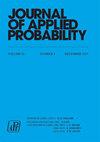多类型生-死过程的渐近持续时间公式
IF 0.7
4区 数学
Q3 STATISTICS & PROBABILITY
引用次数: 0
摘要
摘要我们考虑一类描述由k类个体组成的群体的过程。这个过程几乎可以肯定在有限的时间内在原点被吸收,我们研究了这种灭绝发生所需的预期时间。我们从单个个体或准平衡状态出发,在系统大小参数N趋于无穷大的极限下,推导出该预期持续时间的简单而精确的渐近估计。我们的过程不必是${\mathbb Z}_+^k$上的马尔可夫过程;我们允许个体的寿命可能遵循比指数分布更一般的分布。本文章由计算机程序翻译,如有差异,请以英文原文为准。
Asymptotic persistence time formulae for multitype birth–death processes
Abstract We consider a class of processes describing a population consisting of k types of individuals. The process is almost surely absorbed at the origin within finite time, and we study the expected time taken for such extinction to occur. We derive simple and precise asymptotic estimates for this expected persistence time, starting either from a single individual or from a quasi-equilibrium state, in the limit as a system size parameter N tends to infinity. Our process need not be a Markov process on
$ {\mathbb Z}_+^k$
; we allow the possibility that individuals’ lifetimes may follow more general distributions than the exponential distribution.
求助全文
通过发布文献求助,成功后即可免费获取论文全文。
去求助
来源期刊

Journal of Applied Probability
数学-统计学与概率论
CiteScore
1.50
自引率
10.00%
发文量
92
审稿时长
6-12 weeks
期刊介绍:
Journal of Applied Probability is the oldest journal devoted to the publication of research in the field of applied probability. It is an international journal published by the Applied Probability Trust, and it serves as a companion publication to the Advances in Applied Probability. Its wide audience includes leading researchers across the entire spectrum of applied probability, including biosciences applications, operations research, telecommunications, computer science, engineering, epidemiology, financial mathematics, the physical and social sciences, and any field where stochastic modeling is used.
A submission to Applied Probability represents a submission that may, at the Editor-in-Chief’s discretion, appear in either the Journal of Applied Probability or the Advances in Applied Probability. Typically, shorter papers appear in the Journal, with longer contributions appearing in the Advances.
 求助内容:
求助内容: 应助结果提醒方式:
应助结果提醒方式:


